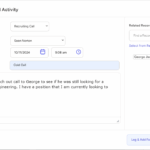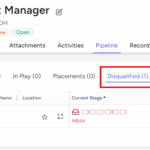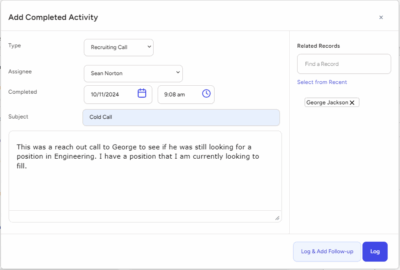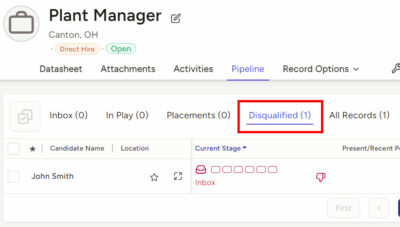Recruiters and hiring managers are constantly juggling multiple responsibilities, from sourcing candidates to scheduling interviews, managing client relationships, and providing feedback. One of the most significant challenges they face is that many applicant tracking systems (ATS) and recruitment software are overly manual and time-consuming. These tools often require excessive data entry, human intervention, and administrative effort, leaving recruiters feeling like they are working for the software, not the other way around.
At CATS, we believe that recruitment technology should work for you. It should streamline your hiring process, automate tedious tasks, and free you up to focus on what truly matters—building meaningful relationships with candidates and clients. This is where recruitment automation comes in, transforming your ATS from a passive tool into an active partner in your recruitment efforts.
In this article from Top Echelon Recruiting Software, we will explore the future of recruitment automation and how an ATS should work for YOU.
The Problem with Traditional ATS Systems
Traditional applicant tracking systems help manage recruitment processes, but they are often too dependent on manual input. The system’s value is limited if you have to continually update records, send out communications, or move candidates through hiring stages without any automation.
Here’s why traditional ATS systems fall short:
- Data Entry Overload: Recruiters spend too much time entering data, whether it’s importing resumes, updating candidate statuses, or scheduling interviews.
- Lack of Automation: Most ATS systems rely on human intervention for every step of the process. This passive approach leads to inefficiencies.
- Time-Consuming Processes: Recruiters are bogged down with administrative tasks that prevent them from focusing on core recruitment activities, such as evaluating candidate fit and communicating with clients.
At CATS, we envision a different reality, one where recruitment automation drives efficiency and allows recruiters to be more effective. But first, let’s clarify what an ATS is and how it fits into the recruitment landscape.
What is an Applicant Tracking System (ATS)?
An Applicant Tracking System (ATS) is software designed to manage the recruitment process, from job posting to candidate screening, scheduling interviews, and making final offers. The first ATS platforms appeared during the early dot-com boom, simplifying the overwhelming influx of job applications and allowing recruiters to filter and manage candidates more effectively.
Founded in 2005, CATS was born from the recognition that the hiring process could—and should—be easier. Over the years, ATS platforms have evolved into powerful tools that streamline hiring, but many remain reliant on manual processes. Choosing the right ATS is essential, as the right system can make recruiting fast and painless, while the wrong one can create bottlenecks and inefficiencies.
The right ATS should:
- Simplify candidate management: Track all candidate interactions, applications, and resumes in one place.
- Automate repetitive tasks: Use triggers and workflows to automate status updates, emails, and task assignments.
- Integrate with job boards: Allow recruiters to post job openings across multiple platforms with ease.
What is Workflow in Recruitment?
In recruitment, a workflow refers to the series of tasks and processes that recruiters perform daily to move candidates from the application stage to being hired. It involves everything from reviewing resumes and conducting interviews to negotiating offers and communicating with clients.
The formal definition of a workflow, as per the BPM Glossary, is:
“An orchestrated and repeatable pattern of business activity enabled by the systematic organization of resources into processes that transform materials, provide services, or process information.”
Simply put, workflows are the routine tasks recruiters perform repeatedly to keep the hiring process moving. These tasks are often monotonous but necessary for recruitment success. Without an efficient workflow, recruiters spend too much time on administrative tasks and not enough time on high-value activities, such as evaluating candidate fit or building relationships.
Common Workflow Tasks in Recruitment:
- Reviewing and screening resumes.
- Sending emails to candidates and clients.
- Updating candidate statuses in the ATS.
- Scheduling interviews and follow-ups.
- Tracking job orders and reporting.
The key to improving recruitment workflow is automation. Recruitment automation can transform these repetitive, manual tasks into streamlined, automated processes.
What is Recruitment Automation?
Recruitment Automation is the future of hiring. It refers to using intelligent, customizable software to automate repetitive and time-consuming recruitment tasks. Instead of manually reviewing resumes, sending emails, or updating candidate statuses, recruitment automation allows you to set up triggers and workflows that handle these tasks for you.
By eliminating unnecessary manual work, recruitment automation lets recruiters focus on more strategic tasks, such as sourcing top candidates, building relationships, and assessing cultural fit. With the right automation tools in place, recruiters can handle more candidates, provide a better experience for job seekers, and increase their overall efficiency.
Key Features of Recruitment Automation:
- Resume Inbox and Parsing: Automated resume parsing can extract key details from resumes and populate candidate profiles without manual data entry.
- Browser Add-Ons: Integrate with platforms like LinkedIn or job boards to automatically import candidate data into your ATS with a single click.
- Triggers and Workflows: Set up triggers that automate tasks based on specific actions. For example, when a candidate submits an application, a trigger can automatically send a confirmation email and move the candidate to the next stage in the process.
- Communication Automation: Automatically send personalized emails to candidates at different stages of the hiring process, such as interview reminders or rejection letters.
- Task Automation: Automatically assign tasks to team members based on workflow stages, ensuring everyone knows what needs to be done next.
By integrating these features, recruitment automation reduces time spent on mundane tasks, improves candidate experience, and allows recruiters to focus on the most human aspects of hiring.
The Evolution of CATS: From Staffing Agency to Recruitment Automation Leader
The concept of recruitment automation isn’t just a trend at CATS—it’s the foundation of our product. Over a decade ago, our founder worked in a staffing agency and struggled with the inefficiencies of manual recruitment processes. He saw firsthand how time-consuming it was to keep clients and candidates updated on the status of their applications and realized that traditional hiring practices were outdated.
Frustrated by these inefficiencies, he launched CATS in 2005 with a vision to automate the recruitment process and empower recruiters to work more effectively. Over the years, we have refined our product and developed a workflow engine that helps recruiters streamline their tasks and focus on what matters most—finding the right talent.
How CATS Stands Out:
- Automation-Centric Design: From day one, CATS has been designed with automation in mind. We’ve built features that minimize manual input and allow recruiters to automate repetitive tasks.
- Customizable Workflows: We know that every recruiter’s process is unique, which is why we offer customizable workflows. Whether you’re working in a small agency or a large corporate HR department, you can tailor CATS to fit your exact needs.
- Continuous Improvement: We are constantly updating and adding features to enhance our users’ experience. From browser extensions to automated resume parsing, CATS continues to evolve with the changing needs of recruiters.
How Recruitment Automation Makes You Better at Your Job
At its core, recruitment automation isn’t just about saving time—it’s about making recruiters more effective at their jobs. By taking mundane tasks off your plate, automation frees you up to focus on the high-level work that adds real value to the recruitment process.
Key Benefits of Recruitment Automation:
- Improved Efficiency: Automation allows recruiters to manage more candidates and job orders simultaneously, improving productivity without sacrificing quality.
- Reduced Time-to-Hire: Automating tasks like candidate communication and interview scheduling speeds up the hiring process, reducing the time it takes to fill positions.
- Better Candidate Experience: Candidates appreciate timely updates and quick responses. Automation ensures that no candidate falls through the cracks and that communication remains consistent and professional.
- Data-Driven Decisions: With automated tracking and reporting, recruiters can analyze data to identify trends, measure performance, and make more informed hiring decisions.
A New Series: Navigating the Future of ATS and Recruitment Automation
This article marks the beginning of a new series designed to help recruiters navigate the future of ATS and recruitment automation. We’ll dive deeper into how CATS and other automated recruitment solutions can optimize your time, help you overcome common hiring challenges, and ultimately make you better at your job.
Through real-world case studies and examples, we’ll follow four recruiters working in different environments—some self-employed, some in large firms—to explore how recruitment automation addresses their unique challenges. Whether you’re an independent recruiter or part of a corporate HR team, this series will provide insights on how to make the most of automation technology.
Conclusion: Embrace the Future of Recruitment with Automation
Recruitment automation is more than just a convenience—it’s a competitive advantage. In today’s fast-paced hiring environment, manual processes slow recruiters down, increase the risk of errors, and limit productivity. By embracing automation, you can transform your ATS into a powerful tool that works for you, helping you find top talent faster and more efficiently.
At CATS, we believe that recruitment software should enable you to focus on the human aspects of hiring, while the technology takes care of the rest. As recruitment continues to evolve, so will our commitment to providing the automation tools you need to succeed.
Stay tuned for our upcoming series, where we’ll explore how recruitment automation can revolutionize your hiring process, no matter where you are in your recruitment journey.








